Lighting is one of the major end uses for electricity, and accounts for almost 15% of global power con-sumption worldwide (Enlighten-initiative.org, 2016). In the USA alone in 2012, lighting in residential and commercial sector accounted for about 461 billion kWh (Eia.gov, 2016). According to the IEA (2006) by adopting a "Least Life-Cycle Cost" strategy energy policy, electricity consumption in the year 2030 can be reduced by 38.4% compared to a reference scenario limited to current energy policy (base year 2006). Global lighting electricity consumption has increased steadily and it will continue increasing in future, if the current energy policy is not changed. Without a change in energy policy, global electricity demand for grid-based lighting will further grow over the next years and decades. The enlighten-initiative of UNEP is expecting that over the next 20 years global electricity consumption for lighting will increase by 80%. By switching efficient lighting technologies it is estimated that globally 939 billion kWh of electricity can be saved annually which is approximately five per cent of global electricity con-sumption (Enlighten-initiative.org, 2016).
In this section, you will find an overview about why good lighting is important, some relevant aspects to consider about energy-efficient lighting, how lighting needs are spread between the residential, commercial, industrial sectors and outdoor lighting, and how lighting needs differ between world regions and countries. We will also highlight the economic advantages of efficient lighting as a target for energy policy.
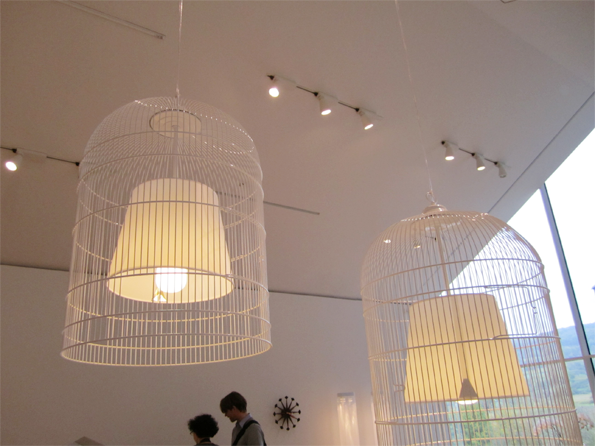
Lighting should meet high visual ergonomic standards, promote a sense of wellbeing and be good for our health. It is important to save energy. However, the desire to save energy and costs should not sacrifice lighting quality. Our eyes perceive most of the information received about our surroundings and without good lighting, the visual perception is poor, a lot of information is lost and the efficiency of work and learning is low. Furthermore, insufficient light or darkness gives rise to a sense of insecurity while artificial lighting during the hours of darkness makes us feel safe. Therefore, light not only enables us to see, it also affects our mood and sense of wellbeing. Insufficient or uncomfortable lighting might be very costly as it reduces productivity in industry and education.
As will be demonstrated here, adequate and efficient lighting doesn’t require more electricity. You will find evidence that there is a high potential for optimizing the lighting systems in commercial and public buildings and that also in residential buildings saving electricity and other costs is possible through highly energy-efficient technologies and better planning.
First we summarise some relevant aspects of efficient lighting and what causes lighting demand, then the sectors, which may benefit most greatly from efficient lighting are considered. There is a large saving potential world wide, but there are differences of the lighting energy use and saving potential in different world regions. Efficient lighting can deliver energy and CO2 savings at negative cost but in all regions there is a high saving potential. Last but not least you will find some basic definitions for the lighting sector.
Lighting helps us to perform our daily tasks. At a desk, at a machine or in the kitchen lighting needs to provide optimal work area illumination or just a comfortable ambient illumination. The illuminance should be related to the visual task and distributes luminance evenly in the room or concentrated to the spot where it is needed. The requirements for different tasks and situations define the quality criteria a lighting system needs to meet.
Good illuminance limits direct and reflected glare and has good colour rending properties. The light it delivers does not flicker and takes account of incident daylight. The illumination can be done with very different technologies. In most cases the planning is not done in a proper and efficient way. That's why electricity for lighting demand in nearly all situations is higher than it could be, if good planning work would have be done and best technologies would have been installed.
It should be stressed that good lighting requires more than putting together some efficient components, a holistic approach is necessary. The first step for new buildings should always be to reduce the need of artificial lighting through design and construction that maximizes the use of daylight. Which specific technology has to be implemented to reach highest efficiency and lowest cost depends on the special task and application of the lighting system be it in the residential or commercial sector (IEA, 2006: 99-104).
The visual tasks in daily life are quite different. Therefore, also the lighting level and other criteria like visual comfort (which is affected by glare, harmonious distribution of brightness, light colour) and direction of light must be adapted accordingly. Efficiency is only one (important) criterion for choosing a lighting system. There are also other criteria in that are applicable in practice:
Electric lighting is used in every sector of the economy. Due to different lighting tasks and requirements different technologies are used in the four sectors described below. Estimated global average share of electric light production by end-use sector and lamp type in the year 2005. The following figure shows the estimated light production within the different end-use sectors and the use of different lamp technologies in 2005 (IEA, 2006).
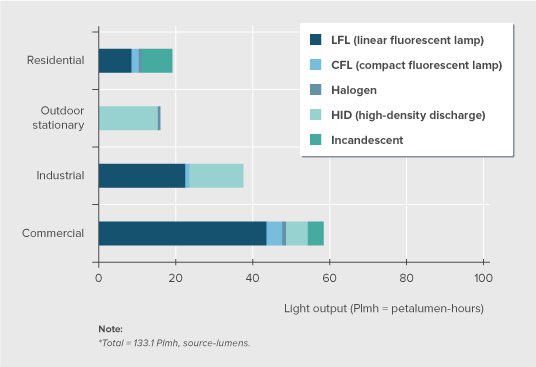
In the year 2005, households used about 31% of worldwide lighting electricity consumption, which was about 811 TWh (IEA, 2006: 183). In the USA lighting energy consumption was about 14 % of total electricity consumption in residential sector (EIA.gov, 2016). With the use of energy-efficient lamps and luminaires, households can save 80 to 90 % of their electricity compared to the conventional light bulb and get the same or better quality lighting. At a non-subsidised energy price, they will also have lower overall costs. By 2030, world electricity demand could be cut by 1,635TWh/yr relative to a reference scenario (current policies) and relative to 2005 from energy-efficient lighting. In the residential sector alone 620 TWh/year can be saved in the year 2030 compared to 2005. That is about 22% of 2005 values and about 15% of the consumption expected in 2030 in the reference scenario (IEA, 2006: 5 & 419).
The efficacy of the lighting systems which are used in the households is often very low, because the incandescent bulb still is the dominant technology in most countries, largely because it is very cheap. This is why there is such a high energy savings potential, for example, by replacing incandescent bulbs by compact fluorescent lamps (CFLs) or even better with light-emitting diode (LED) lamps can typically save around 75 %; replacing halogen and incandescent spotlights by LED spotlights can save around 80%; improving linear fluorescent lamp efficiency with electronic ballasts and efficient T8 or T5 technology can save 30 to 50%.
Worldwide about €82.9 billion (US$ 113 billion) could be saved in power investments, if all incandescent lamps were replaced through CFLs (Enlighten-initiative.org, 2016). However, efficient lighting doesn't come by itself or at least not in the near future. Policy needs to support supply and demand.
In the last years, more and more countries are phasing out incandescent lamps. The aim is to encourage the use of more energy-efficient lighting alternatives, such as CFLs or even better LED lamps. Some governments have passed measures to prohibit the sale of incandescent light bulbs for general lighting. Brazil and Venezuela started to phase them out in 2005, and the European Union, Switzerland, and Australia started to phase them out in 2009. China has decided to do the same in November 2011. Other nations like Argentina, Canada and the USA have planned scheduled phase-outs.
Within the residential sector, the same rules for efficient lighting apply as in other sectors (service sector, industry, street lighting). A distinction of the household sector is that aesthetic design features (rather than efficiency) are influencing the construction and the market of luminaires. As a result, the efficiency of the lamps in the household sector has higher priority than in the other sectors. Control systems are less important in the household sector, because in a domicile it should be possible for the inhabitants to switch on or off the lights whenever required.
About half of the light output in the household sector would still be produced by incandescent and halogen lamps in 2030, if the policy scenario of the year 2005 were to prevail. This means, that more than 80% of the electricity, which is used for lighting, will be consumed by incandescent and halogen lamps.
As a result of the recently decided phase out of incandescent lamps in different parts of the world, it can be expected that the change from incandescent lamps and halogen lamps to compact fluorescent lamps and LED will be much quicker than expected some years ago, because energy and climate policy has realized the chances of efficient lighting and there are more and higher efficient technologies available in the market. In principle every incandescent and halogen lamp can be replaced by a lamp with three to five times its efficacy.
Lighting is a big energy consumer in the commercial and public sector to the extent that it often needs one third of the electricity in a building. Lighting consumption in a typical commercial building consumer anywhere ranges between 15-40 %. EIA (2016) reports that the commercial sector in the USA (including institutional buildings, and public street and highway lighting) consumed about 274 billion kWh for lighting or about 21% of commercial sector electricity consumption in 2012. All over the world, 660 TWh/year of electricity could be saved by 2030 in tertiary sector lighting under a Least Life-Cycle Cost Strategy (LLCC) compared to the current policy scenario (IEA, 2006: 420). With a system optimisation of commercial lighting systems, refurbishments can save more than 50 % in most cases in a cost-effective manner, and large savings are also feasible in new installations.
The tertiary sector is usually defined as everything aside from the household and industry. It covers all commercial facilities (offices, warehousing, shops, retail, hotels, restaurants, etc.) and public buildings (schools, universities, kindergartens, administration buildings, parliaments, gymnastic- and swimming halls, healthcare). Globally about 43% of total lighting electricity consumption was consumed in the commercial sector (includes lighting for commercial and public sector buildings but not street lighting or other outdoor lighting). Within the tertiary sector, lighting tasks are quite different:
In all fields a high saving potential can be achieved through different measures and technologies. Energy savings can be achieved both by new high efficient constructions compared to today’s standard lighting systems and through refurbishment of existing lighting systems. For refurbishment, the energy savings in most cases will be higher than 50% and up to 90%. However, a system optimisation will be needed to achieve such high energy savings. All over the world, 660 TWh/year of electricity (45 % compared to the consumption under the current policy scenario) could be saved by 2030 in tertiary sector lighting alone (IEA, 2006: 398). However, policy will need to support investors in harnessing this potential. Many states have shown the way.
Electricity consumption for lighting varies depending on the building type. While the global average lighting intensity within the tertiary sector in the year 2005 was 32.5 kWh/m2 per year, this varies from 25 kWh/m2 for educational buildings to about 47 kWh/m2 for healthcare buildings (IEA, 2006).
The requirement for lighting and the total energy consumption varies from one type of building to another. Buildings that operate 24 hours per day, seven days by week, like hospitals have the highest energy demand. In those cases also the energy saving potential is high and shows a good benefit-cost ratio. As the benefit-cost ratio is depending on the yearly time-of-use-hours, the benefit-cost ratio in buildings with a low number of operating hours per day (for example some type of schools) is lower, too. Another important aspect is that the saving potential in practice is highly dependent on the existing lighting system. The more inefficient it is, the higher is the energy saving potential and the cost savings of the new system, compared to the old one.
The International Energy Agency estimates the global consumption of light to 133 petalumen-hours per year. While light consumption is quite unevenly throughout the world, the differences in the energy efficiency of lighting are not so big between the regions. The differences can be explained by different lit spaces, different visual comfort and the general influence of GDP to lighting.
Peta - is a prefix in the metric system denoting 10^15 or 1,000,000,000,000,000. That means that if you take the amount of electric lighting generated as measured in lumens, which are in use worldwide and multiply them with the hours that these lumens are used throughout the year, you will get the value of 133 petalumen-hours for the year. On average, this is about 20 megalumen-hours (million lumen-hours) per person. However, the use of light is quite unevenly distributed. While an average North American uses about 100 megalumen-hours, a European only uses less than half of this; a Chinese on average uses only one tenth of the American's lighting consumption; the "rest of world" even uses only 8 megalumen-hours per year.
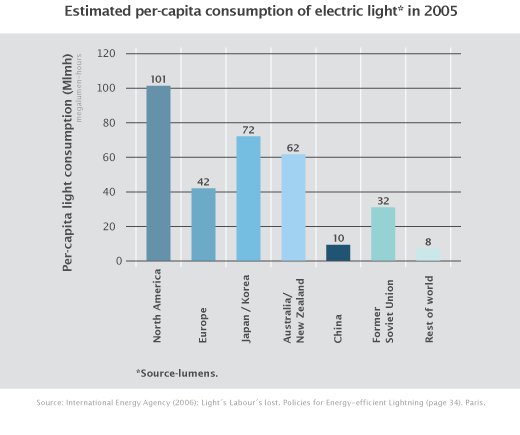
While the use of lumens is quite unequal in the world, it can be seen from the figure below, that the differences related to the luminous efficacy. The efficacy is measured as relation of light (lumen) to the input of power (Watt). The efficacy only is related to the lamp and ballast and doesn’t include the performance of the luminaire, the reflectance of the wall or any control device. The higher efficacy in Japan and China can be explained through the lower fraction of incandescent lamps within these countries.
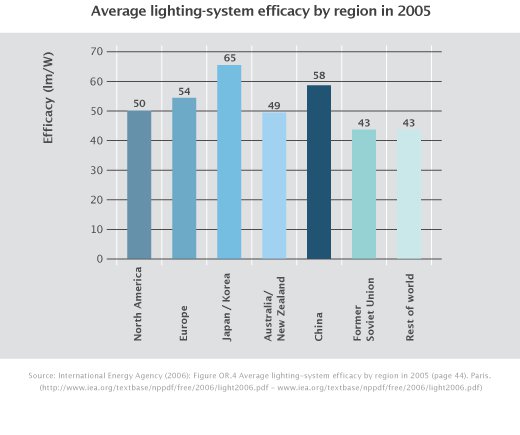
The following figure gives an overview of energy efficiency policies and measures. Nearly all of the following measures can be used in the field of efficient lighting.
Regulation
Education and awareness strategies
Financial instruments
Voluntary agreements and Co-operative instruments
Promotion of energy services for energy savings
Energy efficiency mechanisms, energy efficiency infrastructure, and other combinations of previous (sub) categories
Taxation, subsidy reform, and other fiscal regulations
It should be noted, that a number of obstacles would typically hinder the successful implementation of energy policy. As a result, energy policy design must comprise of an appropriate mix of the above instruments in order to exhaust the available efficiency potentials (Wuppertal Institute/EMEEES, 2009).
The market for lighting in building sector (called general lighting) represents the largest market of about 75 % for lighting among other sectors such as automotive and backlighting. In 2011, total market revenues for general lighting was about EUR 55 billion, which is expected to rise to around EUR 88 billion by 2020 (McKinsey&Company, 2012). Given the rate of market penetration of LEDs, and the volatility in their prices, the price of LEDs in the near future has a significant bearing on the total market value projections.
There is a large energy saving potential world wide for efficient lighting. In general, lighting energy efficiency and the related policies and programmes are very cost-effective and deliver CO2 savings at negative incremental cost. For example, the phase-out of inefficient lighting is one of the most effective low-hanging fruits for countries to combat climate change. The UNEP study "First Generation Country Lighting Assessments' Summary Results, Dec 2010", analysed that through shifting the world’s incandescent lamps to CFLs alone, about 409 TWh of electricity could be saved with a payback-time of one year. That is more than 2% of global electricity consumption (Enlighten-initative, 2016).
However, the cost-benefit relation is always related to the special situation of the existing lighting system and the efficient layout of the programme. Lighting is an obvious target for government energy efficiency programmes. Five arguments will document this:
The LLCC lighting strategy would save end-users about EUR 115.5 billion in total annual lighting costs (equipment, energy and labour) by 2020 or more than EUR 146.8 billion by 2030.
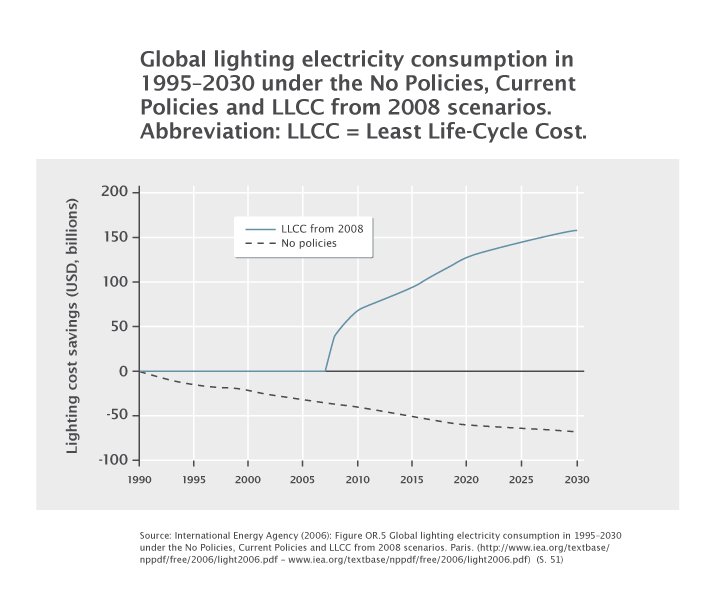
In most cases there is more than one obstacle that will hinder the development and rapid market penetration of efficient lighting products. To make sure (of at least more probable) that new buildings and also refurbished buildings will be equipped with efficient lighting technology some aspects have to be mentioned:
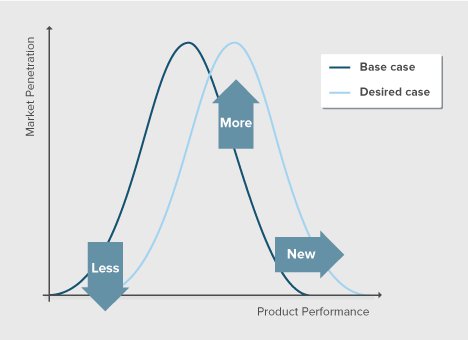
The above figure shows the market penetration of products during their life-cycle. Given this typical process, the aim of efficient lighting policy should be:
For consumers the challenge to choose the appropriate and efficient lamp is growing. In industrial countries the market supply with more or less efficient lamps is growing. This leads to following situations:
All lighting systems, no matter how complex, are made up of three or four basic components:
Tungsten incandescent
The most common incandescent lamps consist of a bulb containing a wire filament that is heated and emits light. The incandescent lamp is the oldest type of electric lamp still in general use. Its practical form was invented in 1879 and while this basic design has undergone numerous changes in materials and manufacturing, the efficacy of such lamps is still low and their average lifetime is quite short (about 1,000 hours). For this reason, many countries around the world have begun phasing out incandescent lamps for more energy-efficient alternatives. The poor efficiency of the lamps and the increasing efforts to fight climate change in many countries has led them to the decision to phase out incandescent lamps.
Tungsten halogen
Tungsten halogen lamps are a derivate of incandescent lamps. In
contrast to incandescent lamps the bulb encasing the filament is filled
with high-pressure halogen gas, which enables higher filament and bulb
wall temperature. The higher temperature increases the lamps efficacy
and also generates a whiter light. The most efficient tungsten
halogen lamps use a multi-layer dichroic metallic coating on the inside
of the capsule. This raises the temperature of the filament and the
efficacy of the system. Infrared dichroic tungsten halogen lamps have an
efficacy of 28-35 lm/W. All halogen lamps are fully dimmable, but
their efficacy declines steeply as they are dimmed (IEA, 2006).
Tungsten halogen lamps using a transformer have longer lamp
life but operate at lower system efficacy because of the energy losses
in the transformer. These may even exist when the lamp is not in use as
the switch is on the low-voltage side of the transformer. Halogen lamps
are about 20 to 50% more efficient than incandescent lamps but still
show a relatively low efficacy. That is the reason why, e.g., in the EU
the less efficient halogen lamps are also included in the phase-out
scheme of the EU.
Compact fluorescent lamp
A fluorescent lamp tube is filled
with a gas containing low-pressure mercury vapour as well as argon,
xenon, neon, or krypton. The inner surface of the bulb or tube is coated
with a fluorescent (and often slightly phosphorescent) coating made of
varying blends of metallic and rare earth phosphor salts. The mercury
atoms in the fluorescent tube must be ionized before the arc can
"strike" within the tube. As a result of this high initial power
requirement fluorescent lamps need a special device known as ballast,
which helps to regulate the electric current through the device.
Ballasts are an important part to many modern high-efficiency lamps and
they can be found as either conventional ballast or electronic ballast.
For CFLs ballasts are usually integrated into the lamp.
Linear fluorescent lamp
Linear fluorescent lampis of a
straight tubular form and bi-pin electrical connections at either end.
T12 (38 mm diameter) was in principle the first linear fluorescent lamp
that dominated the market for a long time. Because its efficacy is quite
low (compared to advanced technologies) it is no longer used in new
installations. The lamp has a diameter of 38 mm. From
1970 onwards, the T12 was increasingly substituted by T8 (26 mm) and T5
lamps (16 mm). The T8 typically has an efficacy 10 to 20% higher than
T12. In countries where the operating voltage is 220 to 240 V, T12 lamps
can directly be substituted through T8. As a result the market-share of
T8 lamps grew quickly in these countries, while in countries witch are
operating at 120V, the T8 lamps require new luminaries which slowed the
penetration of T8 lamps in these areas. The T5 lamp has a higher
efficacy than T8 (about 5 to 10 percent) and reaches an output of up to
105 lumen/Watt. It is always combined with electronic ballast.
Low-pressure sodium vapour lamps
Low-pressure sodium vapour
lamps are discharge lamps in which light is produced by radiation from
sodium vapour. It is the lamp with the highest luminous efficacy rating
(up to 200 lm/W). A key weakness of this class of lights is a very poor
colour rendering index. Low-pressure sodium lamps have an extremely
narrow emission spectrum resulting from the sodium vapour. Since this
light spectrum is very close to peak photonic light sensitivity for
human vision, the efficacy level is very high. Low-pressure sodium lamps
have a colour rendering index of 0. That means that they do not render
colour. For this reason, these lamps are used when colour is
unimportant. They are mostly used in street lighting, parking lots and
security lighting.
High intensity discharge
HID lamps generate light by creating an
electric arc across tungsten electrodes. The electrodes are housed
inside a transparent tube made out of fused alumina or quartz and filled
with different gases and metals. These define the type of HID. The
three main families of HID lamps are mercury vapour, high pressure sodium, metal halide. Other
variety which is less common is the xenon short-arc lamp. In these
lamps, a material, such as sodium, mercury, or metal halide, is added to
the arc tube. The lamp has three electrodes—one acting as a cathode
another as an anode and the remaining electrode used for starting. The
arc tube contains small amounts of pure argon gas, halide salts and
sodium vapour to aid in starting. Free electrons are accelerated by the
starting voltage. In this state of acceleration, the electrons strike
atoms and displace other electrons from their normal atomic positions.
Once the discharge begins, the enclosed arc generates the light source.
HID lamps offer important advantages over incandescent lamps and also
some advantages over fluorescent lamps.
Induction lamp
The basic technology for induction lamps is
not particularly new. Essentially, an induction lamp is an
electrode-less fluorescent lamp. Without electrodes, the lamp relies on
the fundamental principles of electromagnetic induction and gas
discharge to create light. The elimination of filaments and electrodes
results in a lamp of unmatched life. Lasting 100,000 hours or 25 years,
this system can outlast 100 incandescent lamps, five HID lamps, or five
typical fluorescent lamps.
Based on these well-known principles, light
can be generated via a gas discharge through simple magnetism.
Electromagnetic transformers, which consist of rings with metal coils,
create an electromagnetic field around a glass tube which contains the
gas, using a high frequency that is generated by an electronic ballast.
The discharge path, induced by the coils, forms a closed loop causing
acceleration of free electrons, which collide with mercury atoms and
excite the electrons. As the excited electrons from these atoms fall
back from this higher energy state to a lower stable level, they emit
ultraviolet radiation. The UV radiation created is converted to visible
light as it passes through a phosphor coating on the surface of the
tube. The unusual shape of an induction lamp maximizes the efficiency of
the fields that are generated. Although this is not
breakthrough science, until recently, it has not been commercially
viable. New developments have broken down the cost barriers and
technological setbacks, such as EMC interference, lumen depreciation,
ability to dim and a useful range of available wattages. Today the
obvious benefits of induction lamps make it the clear-cut choice for
many lighting applications over traditional lighting options.
Light-emitting diodes (LED)
The new promising technology entering the efficient lighting scene is
LED (light-emitting diodes). This technology has some positive
characteristics which make it interesting for many uses. LEDs were first introduced as indicator lights in the 1960s. At this
time, they were only available in red and had a very low efficiency of
0.01 lm/W. As the efficiency was raised quickly, today's commercial LEDs
are comparable to CFL-Lamps. The typical efficacy of the LED lamps in
the year 2010 was between 30 and 50 lm/Watt. The best LED lamp from the
Swiss "topten" - website (www.topten.ch) in June 2012 was 92 lm/W.
High-Power LEDs can already deliver more than 100lm/Watt and in
laboratory test values up to 200 lm/W have been measured. But until now,
these values have not been transferred into practical applications.
While much attention is placed on LED improvement in terms of lm/Watt it
should be mentioned that the efficiency of the whole system should be
considered which consists of the LED-chips, the optic system and the
driver. But the manufacturers usually only publish values for the
brightness or efficacy of the LED chip which doesn't include driver
losses.
Naked lamps usually do not produce the desired distribution of light and result in a high degree of glare. To improve this situation, the lamps are generally housed inside a luminaire. The primary propose of a luminaire is to distribute the lamp's light into the desired direction and to reduce the effect of glare. The light distribution towards the surfaces that shall be lit can be done in a direct or indirect way. The term luminaire (or fixture) refers to the whole housing of a lamp, including fittings, ballast (in some cases), reflectors, diffusion components and shielding.
The principle construction of a luminaire can be seen in the picture above. It consists of a lamp housing (case), reflector, lamp and ballast (if needed to operate the lamp), sockets and a raster or louver (not in the example shown in the picture). The use of a luminaire in most cases is more effective than using a naked lamp. The use of a naked lamp results in poor light distribution and a high degree of glare (IEA, 2006: 148). With a reflector, light can be directed to where it is needed or distributed evenly and the raster or the louver can help avoid glare.
A luminaire has a significant impact on the overall energy efficiency and quality of lighting installations. A simple measurement of the efficiency of a luminaire is the LOR ratio. This is the ratio of lumens emitted from the luminaire to the total lamp lumen output. This ratio can range from 0.3 (or even lower) to 0.96. (IEA, 2006: 151). This ratio does not take into account the effectiveness of the luminaire at directing light to where it is needed or in the proportions that are needed. For example, a luminaire with a low-er LOR ratio but better diffusers might result in a better illuminance (luminous flux from a light source measured in lux (lx) on horizontal and vertical planes).
Another aspect that has to be mentioned here is that luminaire and lamp must fit together, for instance, if the wrong luminaire is installed, even the most efficient lamp will not lead to efficient lighting.
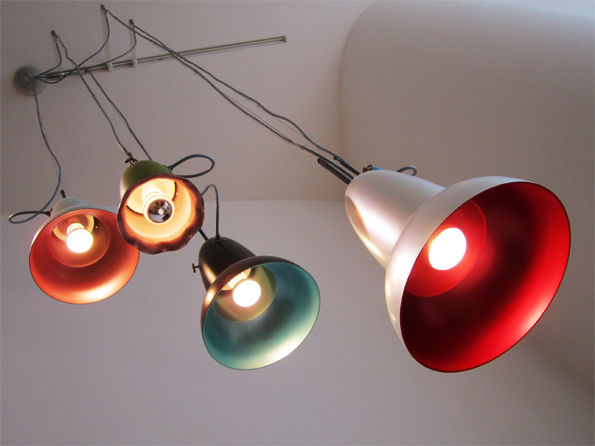
All discharge lamps like fluorescent lamps, low-pressure sodium and High intensity discharge lamps require ballasts to function. The ballasts have the task to provide a high voltage to initiate the discharge of arc and then to stabilize the discharge arc in the lamp during normal operation. There are two broad categories of ballasts (IEA, 2006: 138):
All ballasts require energy to function and furthermore influence the efficacy of the lamp itself. This consideration must be taken into account, when total electricity consumption and total efficacy of a lamp and ballast are assessed. In both ballast categories different quality and efficiencies can be found.
Lighting control systems consists of hardware such as sensors and, relay switches controllers which work using various communication protocols like DALI, enocean etc. DALI is an acronym for Digital Addressable Lighting Interface and is targeted to suit commercial architectural requirements (DALI). DALI is specifically developed for ballasts and relay switches. Lighting communication protocols can be used as a stand-alone lighting control system or integrate with other building automation systems using protocol translation with systems like BACnet, LonWorks etc. The selection of control devices depends on the space layout and the availability of daylight. Energy savings and cost analysis has to be carried out before choosing a particular or a combination of technologies. It has to be noted that dimming is still expensive compared to switching technology and only suits a well daylit area. The following are few populary available lighting controls.
Daylight sensors
Buildings should be appropriately designed for effective distribution of daylight. Daylight sensors sense the amount of daylight illumination available in the space and accordingly reduce the artificial lighting either by turning off or reducing the intensity of lighting through the use of dimmers. Typical lighting sensors used nowadays are based on silicon photo diodes. Photodiodes are photo sensors that generate a current or voltage when the semiconductor is irradiated by light.
Occupancy sensor
Occupancy sensors detect the presence of people in the space and thereby turn on and off the lights accordingly. It is recommended that a manual on and auto off approach should be employed. This increases occupant satisfaction by giving the occupant direct control on the environment while ensuring that the lights turn off automatically while there is no occupancy in the space, thereby minimizing lighting energy wastage due to negligence. An electronic presence detector forms the core-sensing element of an occupancy sensor.
Shading control devices
Shading devices like fixed shades, internal and external blinds, louvers etc. are necessary in passive building design for controlling heat gain and amount of daylight in the space. Automatic window blinds/louver control devices can be used to allow desirable amount of light into the space and also avoid glare. They can be automatically regulated by fixed schedules depending on the Sun path of the place and prevailing ambient light conditions on the outside and can also be manually overridden.
Switches
A simple switch operates on the binary function on/off. A switch can be used to control the lighting using occupancy detectors. It also can be operated based on the schedules of building occupancy and connected to the central BMS system or can operate locally on the basis of manual on and auto off principle. Turning off the lights when not required is the most simple and effective way of conserving energy.
Dimmers
Dimmers control the brightness of the lamp by the use of dimmable ballasts. Unlike old dimmable ballasts that use resistance, reactor and transformer dimmers and loose energy as heat, modern dimmers are based on thyristors, transistors or silicon-controlled rectifiers (SCR).
The saving potential through more efficient lamps is enormous. Compared to incandescent lamps, savings of about 90% can be reached using other efficient lamps. Halogen lamps can be replaced with savings of about 80%. Regarding the efficacy of lamps it has been realized that there are big differences between lamp technologies but also within individual categories.
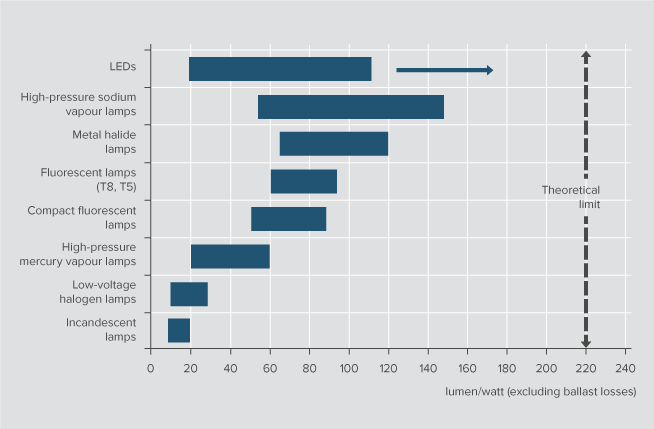
Replacing inefficient lamps is the simplest method to save electricity. If incandescent or halogen lamps are installed, a reduction of electricity consumption of 60 to 85 percent can be achieved. As shown below, even if high quality products like a T5 lamp are installed, additional saving potential are possible through more efficient T5-lamps. In practice it should always be proved, if a better solution can be reached through optimizing the whole lighting system (including luminaire, lamp, ballast, control system) instead of only changing the lamp. The figure above illustrates how LED lamp efficacy can vary from 20 to 110 lumens/Watt. At end of 2011 the best available LED lamps in Europe to substitute a 60 Watt incandescent lamp showed an efficacy of 90 lumen/Watt. However, further improvement can be expected.
The lighting industry has made remarkable improvements in relation to the efficiency of lamps, luminaires and control systems. These improvements result in important differences and variation in terms of lamp efficacy, luminaire efficacy, lifetime, durability, temperature sensitivity, investment and maintenance costs.
Dieter Seifried (Author)
Antoine Durand (Reviewer)

makes energy efficiency in buildings and appliances transparent. For investors, policy-makers and actors involved in implementation and consultancy. Learn more ...

© 2024 | Built by the Wuppertal Institute for Climate, Environment and Energy | All rights reserved. | Imprint | Privacy Policy
